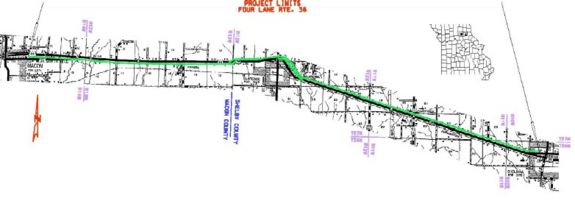104.7 Scoping Estimates: Difference between revisions
mNo edit summary |
m updated link to STIP |
||
| Line 5: | Line 5: | ||
|'''Related Information''' | |'''Related Information''' | ||
|- | |- | ||
|[http://modot.org/plansandprojects/construction_program/ | |[http://www.modot.org/plansandprojects/construction_program/STIP2017-2021/index.htm MoDOT's STIP website] | ||
|- | |- | ||
|'''Figures''' | |'''Figures''' | ||
Revision as of 13:02, 13 July 2016

| Related Information |
| MoDOT's STIP website |
| Figures |
| Engineering Factors Report |
| Cost Estimate Guide for rural preliminary design |
Project scoping estimates based on cost per mile factors shall in no case be considered to contain sufficient detail to allow their inclusion in the STIP. The Cost Estimate Guide for rural preliminary design includes cost per mile factors derived from similar projects as well as the generic factors. In addition, estimates of right of way costs based on generic land values will not be considered to provide the level of confidence that MoDOT requires to make STIP commitments.
The best type of estimate that can be produced at this stage of project development is a historic-based estimate. Based on the quantities calculated from the preliminary plans and historical data from previous bid openings, a fairly accurate estimate can be produced. The methodology of this type of estimate is the same as that used to produce the Engineer’s Estimate described in EPG 103.1.8 Engineer's Estimate.
While the scoping estimate is only based on preliminary quantities, the preliminary plans should provide enough detail to allow a fairly accurate estimate of the major project quantities. Generally, 80% of the cost of a project will be included in the 20% of the pay items that comprise the major items included in the project. Most typically these items will consist of the grading, drainage and paving quantities.
Tentative right of way lines included on preliminary plans will provide a reasonable estimate of the easements and right of way required for each project. These can then be combined with an estimated amount for each property to arrive at a fairly accurate right of way estimate.
By their nature some projects are not as complex as others and the determination of accurate cost estimates and schedules does not require the same level of effort to reach an acceptable level of project detail. These less complex projects typically also have a much smaller budget and overall project development timeline. In fact, the need may not be identified and delivered to the project manager until the anticipated construction year is within the first few years of the STIP. For these projects it will be acceptable to include a cost adjustment factor with the estimates to compensate for the unknown factors that may not be identified as a result of the short amount of time provided to scope the project. Typical examples of this type of project are minor resurfacing, contracted maintenance, or level course projects. Most projects will not fall into this category.

| Historic Engineering Factors Reports |
| CY 2006 - 2008 |
| CY 2007 - 2009 |
| FY 2008 - 2010 |
| FY 2010 - 2012 |
| FY 2011 - 2013 |
| FY 2012 - 2014 |
| FY 2013 - 2015 |
The majority of projects are more complex, typically include a much larger budget, and require a greater level of effort to achieve accurate estimates of cost and schedules. For these projects the inclusion of a cost adjustment factor is not an acceptable substitute for completing all the steps of the project scoping process necessary to properly define the parameters of the project.
All other anticipated right of way and construction costs should also be included in the project estimate. These may include Heritage and Homestead Valuation adjustment costs for large utility relocations, incentive/disincentive clauses, contract acceleration clauses, major environmental mitigation costs, etc. The Engineering Factors Report is a useful document to help calculate a project's future engineering costs such as preliminary and construction engineering and right of way incidentals. The report is updated annually.